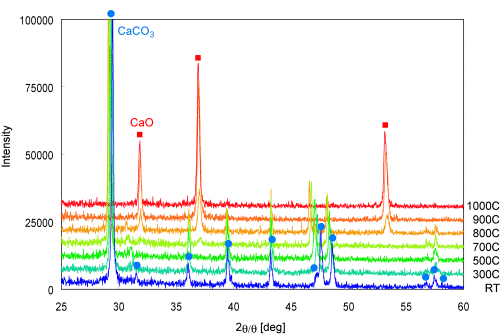Background
The ability to measure samples under specific non-ambient conditions is essential in the research and development of many advanced materials. The Ultima IV has a wide range of fully integrated non-ambient configurations, including the world's only commercially available combined XRD/DSC system. Non-ambient capabilities include:
Investigation
Collecting XRD data at variable temperatures can provide structural information on materials under conditions similar to those in which the material will ultimately be used. In this example the Ultima IV with CBO in focusing mode coupled with a high speed position sensitive detector is used to collect high speed (two minutes per scan) diffraction data from a CaCO3 sample undergoing a thermally induced reaction to CaO. The transition to CaO can be seen to occur at approximately 800°C.

Perhaps the most unique non-ambient capability of the Ultima IV is the combined XRD and DSC configuration. The ability to measure combined XRD/DSC data from the same sample at the same time can be critical in the accurate study of heat based transitions in many materials. The figure to the left shows the combined XRD/DSC data display in which multiple XRD patterns, the variable temperature curve, and the associated heat flow data can be observed. In this example a sample KNO3 observed as the material undergoes three distinct, reversible solid state transitions.

The Ultima IV combined XRD/DSC configuration can also operate under conditions of variable humidity. In this configuration hydration reactions can be studied as a function of both variable temperature and variable humidity. In the figure to the left XRD patterns at variable temperatures from 50 to 275°C were collected from a trihalose sample under constant humidity. As in the example above the XRD patterns, temperature curve, and heat flow data are displayed. A crystalline anhydrous phase is directly generated under theses conditions as indicated by the XRD data.

